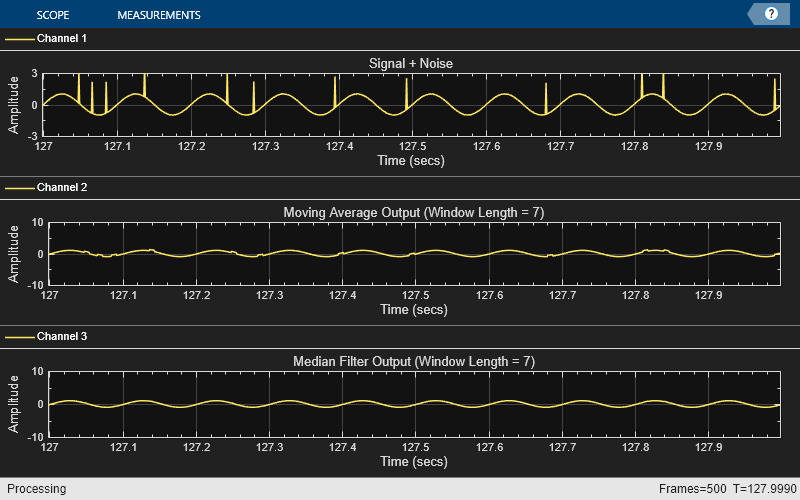dsp.MedianFilter
Median filter
Description
The dsp.MedianFilter
System object™ computes the moving median of the input signal along each channel, independently
over time. The object uses the sliding window method to compute the moving median. In this
method, a window of specified length is moved over each channel, sample by sample, and the
object computes the median of the data in the window. For more details, see Algorithms.
The dsp.MedianFilter object and the movmedian function both compute the moving median of the input signal. However,
the object can process large streams of real-time data and handle system states automatically.
The function performs one-time computations on data that is readily available and cannot
handle system states. For a comparison between the two, see System Objects vs MATLAB Functions.
To compute the moving median of the input:
Create the
dsp.MedianFilterobject and set its properties.Call the object with arguments, as if it were a function.
To learn more about how System objects work, see What Are System Objects?
Creation
Syntax
Description
medFilt = dsp.MedianFiltermedFilt, using the default properties.
medFilt = dsp.MedianFilter(Len)WindowLength property to Len.
medFilt = dsp.MedianFilter(Name,Value) specifies the
WindowLength property using a Name,Value
pair.
Example:
movMin = dsp.MedianFilter('WindowLength',5);Properties
Usage
Syntax
Description
Input Arguments
Output Arguments
Object Functions
To use an object function, specify the
System object as the first input argument. For
example, to release system resources of a System object named obj, use
this syntax:
release(obj)
Examples
Algorithms
References
[1] Bodenham, Dean. “Adaptive Filtering and Change Detection for Streaming Data.” PH.D. Thesis. Imperial College, London, 2012.
Extended Capabilities
Version History
Introduced in R2016b
See Also
Functions
Objects
dsp.MovingMaximum|dsp.MovingMinimum|dsp.MovingAverage|dsp.MovingRMS|dsp.MovingVariance|dsp.MovingStandardDeviation


